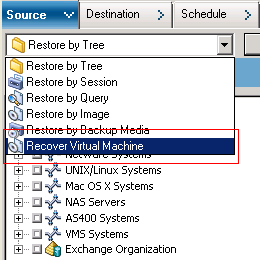Recover Hyper-V Virtual Machines
The process of recovering Hyper-V VMs lets you recreate the entire VM and restore its data. Using this process you can recover a VM from a disaster and clone a VM.
Browsing the Recover VM Window
The Recover VM window lets you browse, select, and modify various fields. When you rest your mouse pointer over an editable field, the background color of the field appears yellow.

To modify an editable field, select the target field and then click the ellipsis to browse the field.
![]()
Considerations
Be aware of the following consideration:
The target VM should be powered off and deleted from the system or renamed. If the VM is not powered off and deleted or renamed, the restore process overwrites the data on the target VM.
To recover Hyper-V virtual machines
- Open the Restore Manager, click the Source tab, and select Recover Virtual Machine from the drop-down list.

- The Restore Virtual Machine window opens.
- To search for a Hyper-V VM, perform one of the following actions and then go to the next step.
- To search for a specific VM, specify the name of the VM in the Virtual Machine Name field, and click Query.
- The Virtual Machine Name specified displays in the VM list.
- To search for all VMs, select << ANY >> in the Virtual Machine Name field and click Query.
- All the VMs in your environment display in the VM list.
- To search using a partial Virtual Machine Name, replace the unknown characters with an asterisk, and click Query.
- The Virtual Machines equaling the search criteria display in the VM list.
- Example: Using 100-* returns the names of all VMs that start with 100-, such as 100-1, 100-01, and 100-001.
- In the Search for virtual machine box, click Hyper-V.
- All the Hyper-V VMs in your environment display in the VM list.
- Complete the following fields in the VM list.
- VM Name (DNS Name)--Check the check box next to VM Name to specify the VMs that you want to recover.
- Backup Versions--Lets you specify a Backup Version.
- You can accept the Backup Version displayed or click in the Backup Versions field and then click the ellipsis to search for multiple versions of the backup data.
- Host Name--Lets you specify the host Hyper-V system and the security information required to recover the VM image.
- If you want to recover the Hyper-V system to a different Hyper-V host, you must specify the directory where you want to recover the VM image.
- Path--Lets you specify the path where you want to recover the VM image.
Note: Arcserve Backup processes the restore operations sequentially when you specify more than one VM.
Note: If the Path field is blank, Arcserve Backup recovers the VM image to its original location.
- Click Options on the toolbar.
- The Global Options dialog opens.
- Click the Operation tab and specify the option that follows:
- Note: The option that follows does not appear on the Operation tab unless the Recover Virtual Machine method is specified.
- Power on VMware or Hyper-V VM after restore--Lets you power on the VM after the recovery is complete.
- Default value: Enabled.
- Example: Specify this option when you must use the VM immediately after the recovery is complete.
- Click OK.
- The options are applied.
- Click Submit to submit the restore job.
- The Submit Job dialog opens.
- On the Submit Job dialog, select Run Now to run the job immediately, or select Run On and select a future date and time when you want the job to run.
- Enter a description for your job and click OK.
- The job is submitted.
- Note: For more information about submitting jobs, see the Administration Guide.
